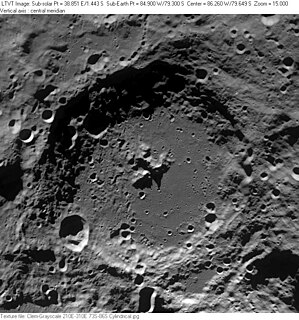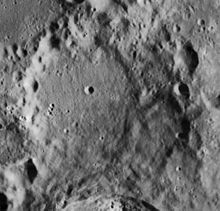
Abenezra is a lunar impact crater located in the rugged highlands in the south-central section of the Moon. Abenezra is named after the Sephardic Jewish sage, poet, biblical commentator, astronomer, and astrologer Abraham ibn Ezra, It is attached along the southeast rim to the crater Azophi. To the northeast lies the crater Geber, and further to the southeast is the larger Sacrobosco.

Alhazen is a lunar impact crater that lies near the eastern limb of the Moon's near side. Just to the south-southeast is the crater Hansen, and to the west is the Mare Crisium. The rim of Alhazen is nearly circular, but appears highly oblong when viewed from the Earth due to foreshortening. The inner walls and the crater floor are rugged and irregular. A low ridge joins the south rim of Alhazen with the nearby Hansen. The crater is named after the Arab Muslim scientist, Ibn al-Haytham.

Anděl is a lunar impact crater that lies in the rugged central highlands of the Moon. It was named after the Czech astronomer Karel Anděl. Nearby craters of note include Abulfeda to the south-southeast and Descartes to the east-southeast. About 85 kilometres to the east-northeast of the outer rim is the landing site of the Apollo 16 mission.

Barocius is an ancient lunar impact crater that is located in the rugged southern highlands of the Moon. It was named after Italian mathematician Francesco Barozzi. It lies just to the southeast of the large crater Maurolycus. To the southwest of Barocius is Clairaut, and to the south-southeast lies Breislak.

Asclepi is a heavily eroded lunar impact crater that lies in the rugged southern highlands of the Moon. The outer rim has been worn down and rounded by many millions of years of subsequent impacts, so that it is now nearly level with the surrounding terrain. As a result, the crater is now little more than a depression in the surface. The interior is nearly flat and relatively featureless.

Baco is a lunar impact crater that lies in the rugged southern highlands on the near side of the Moon. The rim and inner wall has been eroded and worn by countless minor impacts since the original formation of the crater. As a result, any terraces have been worn smooth and the rim is overlaid by several tiny craterlets. The interior floor is nearly flat, with no characteristic central peak at the midpoint and no small craters of significance.

Boyle is a lunar impact crater that is located in the southern hemisphere on the rugged far side of the Moon. It is adjacent to the larger crater Hess to the southeast, and lies about midway between the craters Alder to the north-northeast and Abbe to the south-southwest.

Biela is a lunar impact crater that is located in the rugged highlands of the southeastern Moon. It is named after Austrian astronomer Wilhelm von Biela. The crater lies to the east of Rosenberger, to the southeast of the Watt–Steinheil double crater.

Brunner is a lunar impact crater that is located along the eastern limb of the Moon, to the southeast of the Mare Smythii. At this location the crater is viewed from the edge, and so it is not possible to see much detail from the Earth. The visibility of this formation is also affected by libration. The crater lies to the southwest of the walled plain Hirayama, and to the east of the elongated crater Houtermans.

Buffon is a lunar impact crater that is located on the southern hemisphere on the far side of the Moon. It lies a crater diameter south of the large walled plain Chebyshev. To the northeast is the crater Langmuir and to the southwest is Leavitt. Buffon lies nearly at the midpoint between these formations.

Drygalski is a large lunar impact crater that lies along the southern limb of the Moon. It partly overlies the crater Ashbrook to the west on the far side of the Moon. Just to the north of Drygalski is the smaller Boltzmann. The location of this crater restricts its observation from the Earth, and even under conditions of favorable libration it is viewed from the edge. It is only illuminated by the Sun at an oblique angle, and it lies close to the south polar craters that are permanently shielded from sunlight.

Celsius is a small lunar impact crater that is located in the rugged terrain in the southern hemisphere on the Moon's near side. It is named after Swedish astronomer, physicist and mathematician Anders Celsius. It lies less than one crater diameter to the south-southwest of the crater Zagut, and due north of Büsching.

Clairaut is a lunar impact crater that is located in the rugged southern highlands of the Moon's near side. It lies directly to the south of the crater Maurolycus and southeast of Barocius. Just to the southwest is Cuvier.

Chappell is a lunar impact crater that is located on the far side of the Moon, in the northern hemisphere just to the north of the crater Debye. This feature is located in a heavily bombarded section of the surface, and much of the outer rim of the crater is overlain by many smaller craters. The northern rim in particular has been almost completely disintegrated, while small craters also overlie the rim to the northwest and southeast. What remains of the rim forms a rounded, somewhat irregular edge to the crater depression.
Dove is a small lunar impact crater that is located in the rugged lunar highlands in the southeastern part of the Moon. It lies to the north of the prominent crater Pitiscus.

Comrie is a lunar impact crater. It is located on the rugged far side of the Moon relative to the Earth, beyond the western limb. Nearby craters of note include Ohm to the south-southwest, Shternberg to the southwest, and Parenago to the northeast.

Faye is a heavily eroded lunar impact crater in the rugged southern highlands of the Moon. It is named after French astronomer Hervé Faye. It is attached to the northeastern rim of the crater Delaunay, with Donati located just a few kilometers to the northeast. It forms part of a chain of craters of increasing size to the southwest that continues with La Caille and ends with the walled plain Purbach.

Ehrlich is a small lunar impact crater named after the German scientist Paul Ehrlich. It is located in the northern hemisphere on the Moon's far side. It lies within a rugged region that has been extensively bombarded by impacts of comparable size. Ehrlich lies about midway between the craters Parsons to the south and the heavily worn Guillaume to the north.

Evershed is a lunar impact crater on the far side of the Moon, named after the English solar astronomer John Evershed. It is located to the northeast of the larger crater Cockcroft, and to the north of the smaller Van den Bergh.

Fesenkov is a lunar impact crater on the far side of the Moon. It is located to the east-southeast of the prominent crater Tsiolkovskiy, and less than a crater diameter to the north of Stark.





















